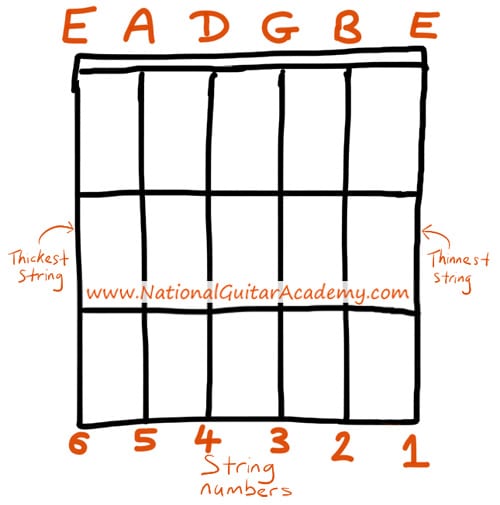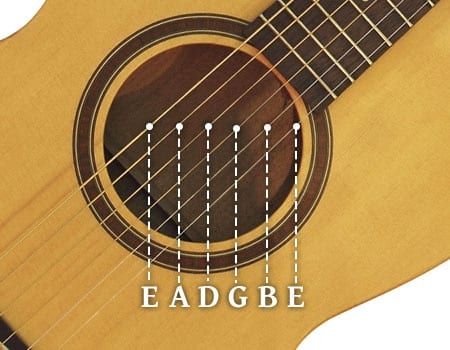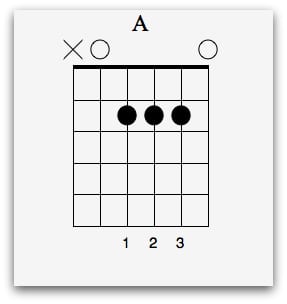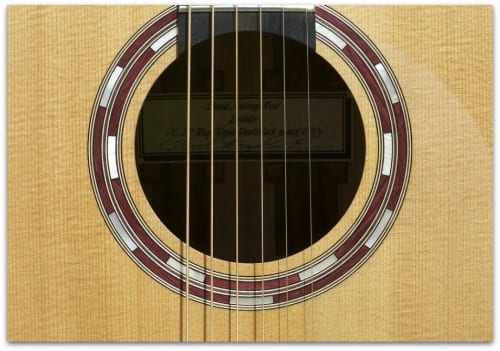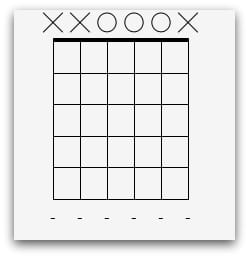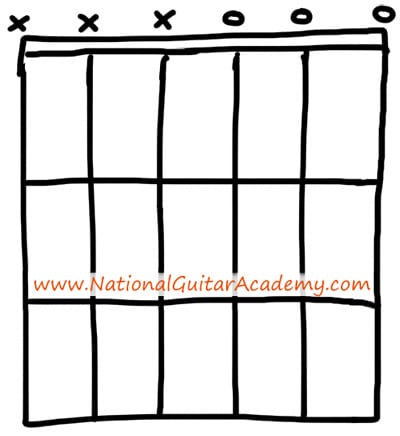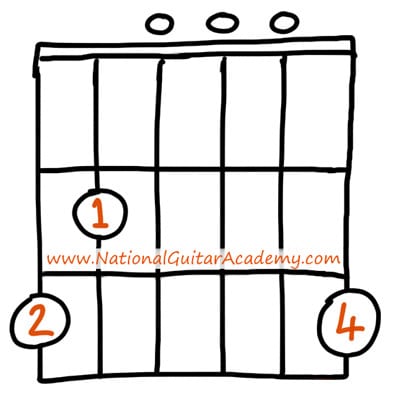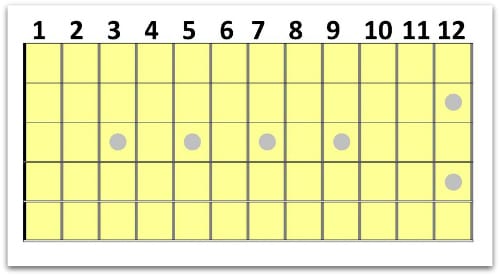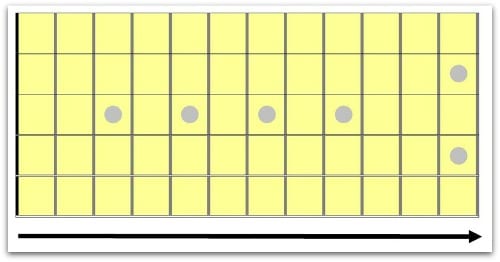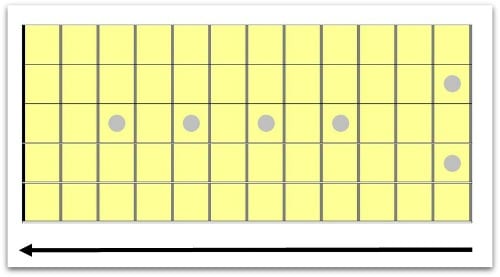To become an epic guitarist, you must understand the notes on a guitar. Luckily, it’s easy to understand. Let’s get started!
In this free guitar lesson you will learn:
- 2 quick and easy ways to remember the names of each guitar string.
- The difference between ‘open’ strings and ‘fretted notes’.
- The no1 secret to learning the notes on a guitar quickly.
- 3 essential tips which will help you maximise your guitar progress.
Over 250,000 guitar-learners get our world-class guitar tips & tutorials sent straight to their inbox: Click here to join them
What Are The Notes On A Guitar?
A guitar has 6 strings. Each string has a name and a number.
Like this:
(If you don't understand the above image please read our article "How To Read Guitar Chordboxes In 60 Seconds". It will make everything clear!)
What are the notes and names of each guitar string?
Here are the names and numbers of every open notes on a guitar.
- 6th String = The E string. (Thickest String.)
- 5th String = The A string.
- 4th String = The D string.
- 3rd String = The G string.
- 2nd String = The B string.
- 1st String = The E string. (Thinnest String.)
Once you’ve learnt these, try and find each of these strings on your guitar.
It’s vital that you know how to tune a guitar. Learn how to here: How To Tune A Guitar The Right Way: A Guide For Beginners
Why do I need to know the notes and numbers of each string?
Guitars aren’t always tuned EADGBE. The tuning of a guitar can change, however the string numbers will NEVER change.
The 6th string will be always be the 6th string.
However, sometimes this string is tuned differently. (The E string is often tuned to a D. It’s confusing to refer to this as ‘the E string’ if the note is wrong!)
To save confusion, it’s vital that you learn the open string notes on a guitar AND the guitar string numbers. That way you have both options, regardless of tuning.
If you’re a beginner, don’t get bogged down in different tunings. Just focus on standard tuning.
How do I remember the open string notes on a guitar?
The best way to remember the names of each guitar string is to think of a really simple rhyme.
Here’s a few of our favourites, these go from the thickest (6th) to the thinnest string.
- Eddie.
- Ate.
- Dynamite.
- Good.
- Bye.
- Eddie.
Or:
- Elephants.
- And.
- Donkeys.
- Grow.
- Big.
- Ears.
You don’t have to start from the thickest string (6th) string. Some people prefer to start their rhymes from the thinnest (1st) string.
This one is great:
- Easter.
- Bunny.
- Gets.
- Drunk.
- After.
- Easter.
There’s no perfect rhyme, just pick the one that sticks in your heard. (The sillier, the better!)
Join over 250,000 guitar learners and subscribe to our guitar-tips-by-email service. (It's free.) We'll send you a series of lessons that will move you to the next level of your guitar journey. Learn how everything fits together quickly, easily and effectively. We share ninja tips (for instant fun!) but also timeless fundamentals that will deepen your understanding. To become a better guitarist click here to see our guitar courses Want us to make a guitar-learning plan that is customised to you? Click here for GuitarMetrics™Want free guitar tips and video lessons delivered to your inbox?
Our Guitar Courses
Get your personalised guitar-learning plan 🎸
What’s the difference between notes on a guitar and chords on a guitar?
- A guitar note refers to a single note.
- Chords are groups of notes put together.
Try and think of notes like letters and chords like words.
Chords form when you group notes together.
What does a guitar note sound like?
Guitar notes are seperate pitches. Here’s a great example of some individual notes:
Click play to hear what an individual note sounds like:
What does a guitar chord sound like?
Chords are formed by stacking guitar notes together.
A guitar chord often features a group of guitar notes played simultaneously.
Here’s an example of a chord:
Click play to listen to this ‘A’ chord.
Can you hear the difference?
The chord sounds bigger than a single note.
Don’t make this mistake!
Don’t try and learn ALL of the notes on a guitar as a beginner. It’s totally overwhelming and unproductive for beginner guitarists.
You must focus ALL your energy on guitar chords.
This is FAR more successful for beginner guitarists.
To begin your guitar journey, try learn a few simple chords and get strumming. Approach the notes on a guitar later.
At some point, you will have to learn about the notes on a guitar, however it’s not vital if you are a beginner guitarist.
For the first six months of your guitar journey, focus exclusively on guitar chords on strumming.
To learn more about these techniques go here:
Learn 12 EASY beginner chords with our popular guide

✅ Stop struggling. Start making music.
✅ Learn beginner-friendly versions of every chord.
This is our most popular guide and it will improve your chord ability quickly! 😎
Get your own personalised guitar-learning plan 🎸
Get a custom guitar-learning plan here: Click here for GuitarMetrics™
World-Class Guitar Courses 🌎
Learn from the world's best guitar educators: Click here for our guitar courses
‘Top’ vs ‘bottom’ strings
When we talk about the top string, we’re actually talking about the high E string. (The 1st string.)
When we talk about the bottom string, we’re referring to the low E string. (The 6th string.)
This is because when we talk about the top and bottom and strings, we’re referring to the pitch of these notes NOT the height.
- The lowest note on the guitar is the low E string. (Thickest string.) This is why we call it the bottom string.
- The highest open string on the guitar is the high E string. (Thinnest string.) This is why we call it the top string.
Have a go at playing your low E string, then playing the high E string.
Can you hear how the low E string sounds deeper and rounder than the high E string?
What is an ‘open’ string?
An open string is a string which is played without placing your hand on the fret board.
If you strum the low E string without fretting a note, you’re playing an ‘open E string’.
You can do this with the rest of the guitar strings.
Try this, can you play?
- The open A string. (5th string.)
- The open D string. (4th string.)
- The open G string. (3rd string.)
- The open B string. (2nd string.)
- The low E and high E strings together! (6th and 1st string.)
What’s the difference between open strings and fretted notes?
Fretted notes require you to push down on a fret with your fingers. (You need two hands to do this, one to press down, the other to pick the note.)
Open strings require you to pluck the guitar string with your picking hand. (You can do this with one hand!)
Bonus Tip! It’s possible to play a guitar chords without fretting any notes.
It’s possible to play guitar chords without fretting ANY notes, let’s find out how..
Open String Chord #1 The ‘G’ Chord
To play this chord, we only need to pluck a few strings.
To play this chord, pluck the following strings at the same time:
- The open D string. (4th string.)
- The open G string. (3rd string.)
- The open B string. (2nd string.)
Open String Chord #2 The ‘Em’ Chord
To play this chord pluck each of these strings at the same time :
- The open G string. (3rd string.)
- The open B string. (2nd string.)
- The open E string. (1st string.)
At first, plucking open strings is fun as it’s SUPER easy. However, it doesn’t get you very far in your guitar journey.
It’s far easier to progress as a guitarist if you learn fretted chords. They sound MUCH better. Let’s take a look at some.
Fretted Chord #1 – The ‘G’ Chord
To play this chord:
- Place your 2nd finger on the 3rd fret of the low E string. (6th string.)
- Place your 1st finger on the 2nd fret of the A string. (5th string.)
- Place your 4th finger on the 3rd fret of the high E string. (1st string.)
To learn more easy chords, check out these lessons
Notes On A Guitar: Unlocking The Fretboard
Now, we’re going to explore the fretboard in more detail. This information is useful but NOT essential. So if you’re a beginner guitarist, feel free to read on! Just tread carefully 🙂
Notes On A Guitar & The Musical Alphabet
The notes on a guitar are EXACTLY the same as any other musical note. The musical alphabet is transferable across all instruments.
There are 12 notes in the musical alphabet, but 26 letters in the normal alphabet.
- The musical alphabet goes from A to G.
- The normal alphabet goes from A to Z.
You may be wondering, ‘That’s only 7 letters from A-G!’
The gap between these notes are filled by sharps and flats. This is what makes up the 12 notes of the musical alphabet.
The 12 notes of the musical alphabet are:
A, A#, B, C, C#, D, D#, E, F, F#, G, G#, A.
Pro Guitar Tip
This ‘#’ is NOT a hashtag. It’s a sharp. If you see this after a letter pronounce it as ‘sharp’. For example A# would read ‘A Sharp’
Sharps or Flats?
Sharps and flats are identical, they are just viewed from a different perspective.
We can view sharps through a ‘flat’ lense.
If we do, the musical alphabet looks like this: A, Bb, B, C, Db, D, Eb, E, F, Gb, G, Ab, A.
For example, A sharp (A#) is also known as “B Flat” (written as Bb). A# and Bb are the same note.
This also applies for other sharps:
- C# (AKA “C sharp”) is the same as Db (AKA “D flat”).
- D# is the same as Eb.
- F# is the same as Gb.
- G# is the same as Ab.
Whenever you see the ‘b’ sign, pronounce it as ‘flat’.
Here’s what the musical alphabet looks like with ALL sharps.
A, A#, B, C, C#, D, D#, E, F, F#, G, G#, A.
Here’s what the musical alphabet looks like with ALL flats.
A, Bb, B, C, Db, D, Eb, E, F, Gb, G, Ab, A.
Can all notes be sharpened or flattened?
No! Let’s find out why.
For this example, we’re going to use the musical alphabet from a sharp perspective.
A, A#, B, C, C#, D, D#, E, F, F#, G, G#, A.
Not all notes have a sharp between them. There are a few exceptions.
Here they are:
- There is no sharp note between B and C. ‘B#’ or ‘Cb’ do not exist.
- There is no sharp note between E and F. ‘E#’ or ‘fb’ do not exist.
.
Applying the musical alphabet to the fret board
Let’s begin with how the notes are laid out on a fret board.
Each fret has a number. This goes up one by one as we ascend the fret board:
If you don’t fret a note, this is known as an open string.
In the guitar world, we think of this as ‘0’.
From 0, we ascend towards the body of the guitar, like this:
When you ascend up the fret board, the notes get higher in pitch.
How do I practice the notes of the musical alphabet?
The secret to practicing the musical alphabet on a guitar is to start on the open A string (5th string) and progress up one fret at a time.
Whilst you do this, name each note until you get to the 12th fret.
- Start with the open A string. (5th string.) This is an A note.
- Ascend up one fret and pluck the A string. This as an A# note.
- Keep going until you reach the 12th fret.
- These are each of the notes that you will play as you ascend up the fret board.
A, A#, B, C, C#, D, D#, E, F, F#, G, G#, A.
Congratulations, you’ve just progressed up a WHOLE octave! Awesome 🙂
- If you’ve done this correctly, when you reach the 12th fret you will be back at the note A again. (You’ve progressed to the next octave.)
- If you haven’t, you might have a missed a few notes. So it’s best to go back and check.
- Once you’ve done this, try and descend the fret board. But this time, use flats instead.
To go down the fret board, you have to go the opposite way towards the head stock.
Like this:
From the 12th fret down, this is the layout of the musical alphabet.
A, Ab, G, Gb, F, E, Eb, D, Db, C, B, Bb, A.
This is FAR more difficult, but it is fantastic practice.
This is the most beneficial to develop your fret board knowledge.
Bonus Tip!
To remember the notes faster, say them aloud. This will feel hard at first, but we guarantee that it will be easier in the long run.
What Are All The Notes On A Guitar?
Here are ALL of the notes on a guitar:
To learn more about this diagram go here: Guitar Notes Explained: A Guide For Beginners
If you’re new to the guitar, this diagram might look a like something out of the matrix.
Remember this is just a reference, there’s no way you can learn the notes on a guitar by looking at this diagram alone.
If you’re a beginner it’s not essential that you learn each note on the guitar. However it is important that you…
1) Learn Guitar Chords
Guitar chords form 99% of all music, without these you can’t play music. Focus on guitar chords, don’t get bogged down with the notes on a guitar.
Want to learn ALL guitar chords? Go here: Guitar Chord Chart – Learn ALL Chords In ALL Keys
2) Learn Music That You Love
Learn music that you love, it’s fun, enjoyable and the fastest way to learn guitar.
Don’t learn boring exercises, learn songs that you love.
This is article is one of our favourites and will give you the perfect start to your guitar journey: How To Learn Guitar: An 11-Step Programme For Beginners
What Type of Guitarist Are You?
Take our 60-second quiz & get your results: Take The Quiz
Join the world's best online guitar school 🌎
- Get your own personalised guitar learning plan (customised just for YOU).
- World-class online guitar courses. Learn at your own pace.
- Community Campus & Learning Forum - A friendly community! Connect with our team & students. 😊
- Beginner Song library with chordsheets, tabs and tips. (Songs suitable for all levels!)
- Regular live streams, seminars and Q&A sessions - Learn from world-class guitar educators. Get all your questions answered!
Click here to learn more about National Guitar Academy membership 
Cool Guitar T-shirts 😎
Look cooler! Check out our merch: Click here to see our merch store
Want free guitar tips and video lessons delivered to your inbox?
Join over 250,000 other guitar learners and subscribe to our guitar-tips-by-email service. (It's free.)
We'll send you a series of lessons that will move you to the next level of your guitar journey.
Learn how everything fits together quickly, easily and effectively. We share ninja tips (for instant fun!) but also timeless fundamentals that will deepen your understanding.

Popular Lessons
How To Learn Guitar: An 11-Step Programme For Beginners
How To Choose The Perfect Beginner Guitar
More Cool Guitar Stuff
Learn about National Guitar Academy: About Us
Visit our YouTube channel for fun guitar videos.
Join us on Facebook for daily guitar tips.
Listen to our Learn Guitar Podcast for rapid guitar progress.
Check out our free chord lessons.
Get our best guitar tips & videos
Get our best guitar tips & videos
Where should we send it?
Get our best guitar tips & videos

